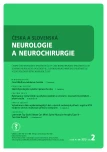Torticollis at Grisel’s Syndrome – Case Reports
Authors:
T. Rybnikár 1; V. Málek 2; P. Čelakovský 1; Viktor Chrobok 1
; Jan Mejzlík 3
; D. Kalfeřt 1; Jana Dědková 4; E. Popper 5
Authors‘ workplace:
Klinika otorinolaryngologie a chirurgie hlavy a krku LF UK a FN Hradec Králové
1; Neurochirurgická klinika LF UK a FN Hradec Králové
2; Klinika otorinolaryngologie a chirurgie hlavy a krku FZS UP a Pardubická krajská nemocnice, a. s.
3; Radiologická klinika LF UK a FN Hradec Králové
4; Rehabilitační klinika LF UK a FN Hradec Králové
5
Published in:
Cesk Slov Neurol N 2013; 76/109(2): 246-249
Category:
Case Report
Overview
Rotational atlantoaxial instability may lead to torticollis and has diverse aetiology. Grisel’s syndrome is one of the potential causes of rotational atlantoaxial instability. Grisel’s syndrome is a rare condition that manifests itself with spastic contraction of the neck muscles that limits movement of the head and neck. It may occur following a surgery, especially otorhinolaryngological, requiring a specific head position with hyperextension or hyperextension with rotation, or in connection with bacterial infections of the cervical area. Increased incidence in adolescence is explained by increased perfusion of the atlantoaxial space and increased ligamentous laxity of the joint capsules and allar ligament length in children with known horizontal orientation of zygapophyzeal joints between the first and the second cervical vertebrae. The presented case reports describe post-surgical development of Grisel’s syndrome in two paediatric patients. The authors highlight the importance of early diagnosis, emphasising interdisciplinary cooperation. Late diagnosis can cause serious complications including root deficits, myelopathy or cosmetic deformity of the cervical spine.
Key words:
Grisel’s syndrome – rotational atlantoaxial instability – torticollis
Sources
1. Doshi J, Anari S, Zammit-Maempel I, Paleri V. Grisel syndrome: a delayed presentation in an asymptomatic patient. J Laryngol Otol 2007; 121(8): 800–802.
2. Lohnert J. Zlomeniny chrbtice. Bratislava: [s.n.] 2000.
3. Herzka A, Sponseller PD, Pyeritz RE. Atlantoaxial rotatory subluxation in patients with Marfan syndrome. A report of three cases. Spine 2000; 25(4): 524–526.
4. Martínez-Lage JF, Morales T, Fernandez Cornejo V. Inflammatory C2–3 subluxation: a Grisel’s syndrome variant. Arch Dis Child 2003; 88(7): 628–629.
5. Deichmueller CM, Welkoborsky HJ. Grisel’s syndrome – a rare complication following “small” operations and infections in the ENT region. Eur Arch Otorhinolaryngol 2010; 267(9): 1467–1473.
6. Grisel P. Enucléation de latlas et torticollis nasopharyngien. Presse Med 1930; 38 : 50–53.
7. Fielding JW, Hawkins RJ. Atlanto-axial rotatory fixation. Fixed rotatory subluxation of the atlanto-axial joint. J Bone Joint Surg Am 1977; 59(1): 37–44.
8. Yu KK, White DR, Weissler MC, Pillsbury HC. Nontraumatic atlantoaxial subluxation (Grisel syndrome): a rare complication of otolaryngological procedures. Laryngoscope 2003; 113(6): 1047–1049.
9. Mathern G, Batzdorf U. Grisel’s syndrome – cervical spine clinical, pathologic and neurologic manifestations. Clin Orthop Relat Res 1989; 244 : 131–146.
10. Karkos P, Benton J, Leong SC, Mushi E, Sivaji N, Assimakopoulos DA. Grisel’s syndrome in otolaryngology: a systematic review. Int J Pediatr Otorhinolaryngol 2007; 71(12): 1823–1827.
11. Štulík J et al. Poranění krční páteře. Praha: Galén 2010.
Labels
Paediatric neurology Neurosurgery NeurologyArticle was published in
Czech and Slovak Neurology and Neurosurgery

2013 Issue 2
- Advances in the Treatment of Myasthenia Gravis on the Horizon
- Memantine Eases Daily Life for Patients and Caregivers
- Metamizole vs. Tramadol in Postoperative Analgesia
- Metamizole at a Glance and in Practice – Effective Non-Opioid Analgesic for All Ages
Most read in this issue
- Creutzfeldt-Jacob disease
- Spinocerebellar Ataxia 7 – a Case Report
- Lyme Borreliosis as a Cause of Bilateral Neuroretinitis with Pronounced Unilateral Stellate Maculopathy in a 8-Year Old Girl
- Electrophysiological Examination of the Pelvic Floor
